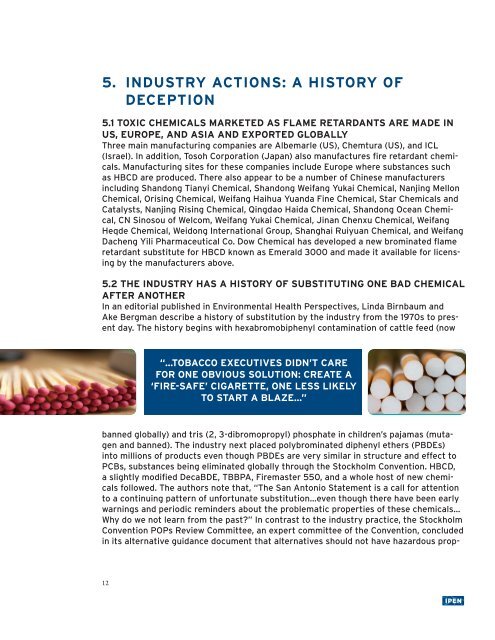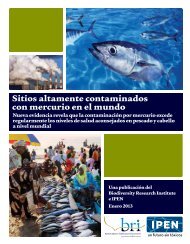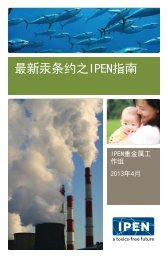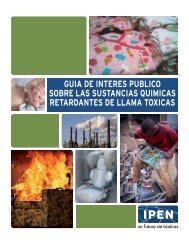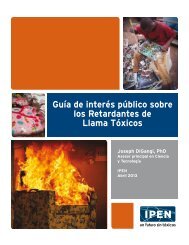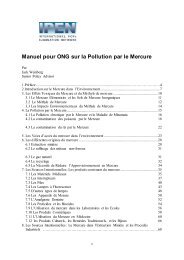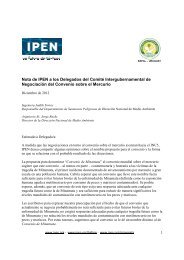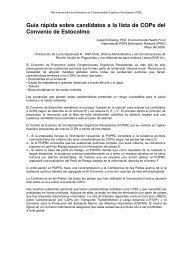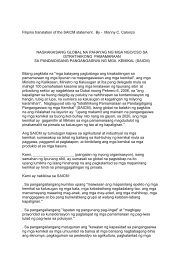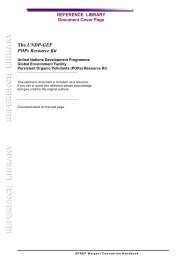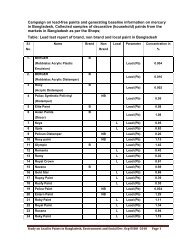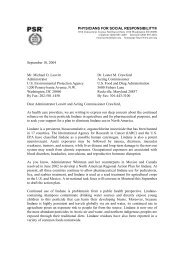A Public Interest Guide to Toxic Flame Retardant Chemicals
A Public Interest Guide to Toxic Flame Retardant Chemicals
A Public Interest Guide to Toxic Flame Retardant Chemicals
You also want an ePaper? Increase the reach of your titles
YUMPU automatically turns print PDFs into web optimized ePapers that Google loves.
5. INDUSTRY ACTIONS: A HISTORY OF<br />
DECEPTION<br />
5.1 TOXIC CHEMICALS MARKETED AS FLAME RETARDANTS ARE MADE IN<br />
US, EUROPE, AND ASIA AND EXPORTED GLOBALLY<br />
Three main manufacturing companies are Albemarle (US), Chemtura (US), and ICL<br />
(Israel). In addition, Tosoh Corporation (Japan) also manufactures fire retardant chemicals.<br />
Manufacturing sites for these companies include Europe where substances such<br />
as HBCD are produced. There also appear <strong>to</strong> be a number of Chinese manufacturers<br />
including Shandong Tianyi Chemical, Shandong Weifang Yukai Chemical, Nanjing Mellon<br />
Chemical, Orising Chemical, Weifang Haihua Yuanda Fine Chemical, Star <strong>Chemicals</strong> and<br />
Catalysts, Nanjing Rising Chemical, Qingdao Haida Chemical, Shandong Ocean Chemical,<br />
CN Sinosou of Welcom, Weifang Yukai Chemical, Jinan Chenxu Chemical, Weifang<br />
Heqde Chemical, Weidong International Group, Shanghai Ruiyuan Chemical, and Weifang<br />
Dacheng Yili Pharmaceutical Co. Dow Chemical has developed a new brominated flame<br />
retardant substitute for HBCD known as Emerald 3000 and made it available for licensing<br />
by the manufacturers above.<br />
5.2 THE INDUSTRY HAS A HISTORY OF SUBSTITUTING ONE BAD CHEMICAL<br />
AFTER ANOTHER<br />
In an edi<strong>to</strong>rial published in Environmental Health Perspectives, Linda Birnbaum and<br />
Ake Bergman describe a his<strong>to</strong>ry of substitution by the industry from the 1970s <strong>to</strong> present<br />
day. The his<strong>to</strong>ry begins with hexabromobiphenyl contamination of cattle feed (now<br />
“...TOBACCO EXECUTIVES DIDN’T CARE<br />
FOR ONE OBVIOUS SOLUTION: CREATE A<br />
‘FIRE-SAFE’ CIGARETTE, ONE LESS LIKELY<br />
TO START A BLAZE...”<br />
banned globally) and tris (2, 3-dibromopropyl) phosphate in children’s pajamas (mutagen<br />
and banned). The industry next placed polybrominated diphenyl ethers (PBDEs)<br />
in<strong>to</strong> millions of products even though PBDEs are very similar in structure and effect <strong>to</strong><br />
PCBs, substances being eliminated globally through the S<strong>to</strong>ckholm Convention. HBCD,<br />
a slightly modified DecaBDE, TBBPA, Firemaster 550, and a whole host of new chemicals<br />
followed. The authors note that, “The San An<strong>to</strong>nio Statement is a call for attention<br />
<strong>to</strong> a continuing pattern of unfortunate substitution…even though there have been early<br />
warnings and periodic reminders about the problematic properties of these chemicals…<br />
Why do we not learn from the past?” In contrast <strong>to</strong> the industry practice, the S<strong>to</strong>ckholm<br />
Convention POPs Review Committee, an expert committee of the Convention, concluded<br />
in its alternative guidance document that alternatives should not have hazardous prop-<br />
12


